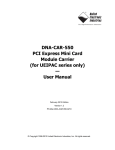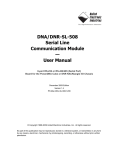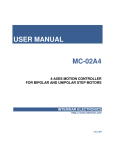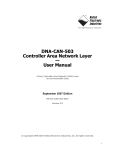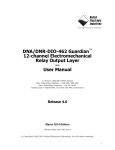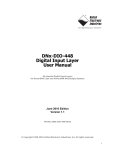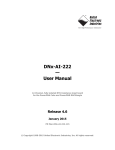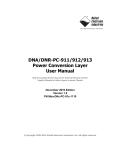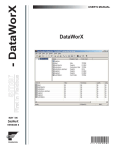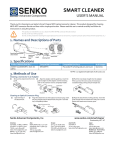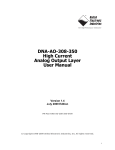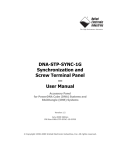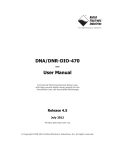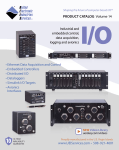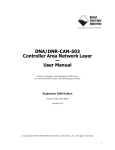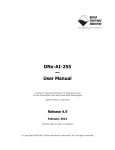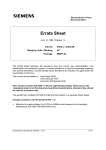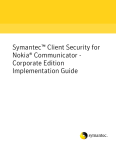Download DNA/DNR-CT-651 Precision Timing Interface Board — User Manual
Transcript
DNA/DNR-CT-651 Precision Timing Interface Board — User Manual January 2010 Edition Version 1.0 PN Man-DNx-CT-651-0110 © Copyright 1998-2010 United Electronic Industries, Inc. All rights reserved. No part of this publication may be reproduced, stored in a retrieval system, or transmitted, in any form by any means, electronic, mechanical, by photocopying, recording, or otherwise without prior written permission. Information furnished in this manual is believed to be accurate and reliable. However, no responsibility is assumed for its use, or for any infringements of patents or other rights of third parties that may result from its use. All product names listed are trademarks or trade names of their respective companies. See UEI’s website for complete terms and conditions of sale: http://www.ueidaq.com/company/terms.aspx Contacting United Electronic Industries Mailing Address: 27 Renmar Avenue Walpole, MA 02081 U.S.A. For a list of our distributors and partners in the US and around the world, please see http://www.ueidaq.com/partners/ Support: Telephone: Fax: (508) 921-4600 (508) 668-2350 Also see the FAQs and online “Live Help” feature on our web site. Internet Support: Support Web-Site FTP Site [email protected] www.ueidaq.com ftp://ftp.ueidaq.com Product Disclaimer: WARNING! DO NOT USE PRODUCTS SOLD BY UNITED ELECTRONIC INDUSTRIES, INC. AS CRITICAL COMPONENTS IN LIFE SUPPORT DEVICES OR SYSTEMS. Products sold by United Electronic Industries, Inc. are not authorized for use as critical components in life support devices or systems. A critical component is any component of a life support device or system whose failure to perform can be reasonably expected to cause the failure of the life support device or system, or to affect its safety or effectiveness. Any attempt to purchase any United Electronic Industries, Inc. product for that purpose is null and void and United Electronic Industries Inc. accepts no liability whatsoever in contract, tort, or otherwise whether or not resulting from our or our employees' negligence or failure to detect an improper purchase. Note: Specifications shown in this document are subject to change without notice. Please check with UEI for current status. ii iii Table of Contents Chapter 1 Introduction . . . . . . . . . . . . . . . . . . . . . . . . . . . . . . . . . . . . . . . . . . . . . . . . . . . . 1 1.1 Organization of this manual . . . . . . . . . . . . . . . . . . . . . . . . . . . . . . . . . . . . . . . . . . . . 1 1.2 DNx-CT-651 Precision Timing Interface Board Features . . . . . . . . . . . . . . . . . . . . . . 2 1.3 Photos. . . . . . . . . . . . . . . . . . . . . . . . . . . . . . . . . . . . . . . . . . . . . . . . . . . . . . . . . . . . . 2 1.4 DNx-CT-651 . . . . . . . . . . . . . . . . . . . . . . . . . . . . . . . . . . . . . . . . . . . . . . . . . . . . . . . . 2 1.5 1.5.1 1.5.2 Functional Description . . . . . . . . . . . . . . . . . . . . . . . . . . . . . . . . . . . . . . . . . . . . . . . . 3 Registers . . . . . . . . . . . . . . . . . . . . . . . . . . . . . . . . . . . . . . . . . . . . . . . . . . . . . 4 Operation . . . . . . . . . . . . . . . . . . . . . . . . . . . . . . . . . . . . . . . . . . . . . . . . . . . . . 4 1.6 Specifications . . . . . . . . . . . . . . . . . . . . . . . . . . . . . . . . . . . . . . . . . . . . . . . . . . . . . . . 5 1.7 Wiring and Connectors . . . . . . . . . . . . . . . . . . . . . . . . . . . . . . . . . . . . . . . . . . . . . . . . 5 1.8 Pinout . . . . . . . . . . . . . . . . . . . . . . . . . . . . . . . . . . . . . . . . . . . . . . . . . . . . . . . . . . . . . 6 1.9 Jumper Settings for DNA Version . . . . . . . . . . . . . . . . . . . . . . . . . . . . . . . . . . . . . . . . 6 Chapter 2 Programming with the High-Level API . . . . . . . . . . . . . . . . . . . . . . . . . . . . . . . 8 Chapter 3 Programming with the Low-Level API . . . . . . . . . . . . . . . . . . . . . . . . . . . . . . . 9 3.1 Data Representation . . . . . . . . . . . . . . . . . . . . . . . . . . . . . . . . . . . . . . . . . . . . . . . . . . 9 3.2 Configuration Settings. . . . . . . . . . . . . . . . . . . . . . . . . . . . . . . . . . . . . . . . . . . . . . . . . 9 3.3 Layer-specific Commands and Parameters . . . . . . . . . . . . . . . . . . . . . . . . . . . . . . . . 9 Index . . . . . . . . . . . . . . . . . . . . . . . . . . . . . . . . . . . . . . . . . . . . . . . . . . . . . . . . . . . . . . . . . . 10 © Copyright 2010 United Electronic Industries, Inc. Tel::508-921-4600 Date: January 2010 www.ueidaq.com Vers: 1.0 DNx-CT-651-ManualTOC.fm iv List of Figures Chapter 1 Introduction . . . . . . . . . . . . . . . . . . . . . . . . . . . . . . . . . . . . . . . . . . . . . . . . . . . . 1 1-1 DNA-and DNR-CT-651 Precision Timing Interface Boards ........................................... 2 1-2 Block Diagram of DNx-CT-651 Precision Timing Reference ......................................... 3 1-3 Pinout Diagram of the DNx-CT-651 ............................................................................... 6 1-4 Diagram of DNA-CT-651 Layer Position Jumper Settings............................................. 6 1-5 Physical Layout of DNA-CT-651 Layer Board ............................................................... 7 Chapter 2 Programming with the High-Level API . . . . . . . . . . . . . . . . . . . . . . . . . . . . . . . 8 (None) Chapter 3 Programming with the Low-Level API . . . . . . . . . . . . . . . . . . . . . . . . . . . . . . . 9 (None) © Copyright 2010 United Electronic Industries, Inc. Tel::508-921-4600 Date: January 2010 www.ueidaq.com Vers: 1.0 DNx-CT-651-ManualLOF.fm DNx-CT-651 Precision Timing Interface Board Chapter 1 Introduction Chapter 1 Introduction This document outlines the feature-set and operation of the UEI DNA- and DNR-CT-651 Precision Timing Interface boards for use with UEI’s Cube and RACKtangle data acquisition systems. 1.1 Organization This DNA-CT-651 User Manual is organized as follows: of this manual • Chapter 1- Introduction This section provides an overview of the document content, device architecture, functional description, connectivity, and logic of the board. • Chapter 2 – Programming with the High Level API This section explains how to program the CT-651 using the UEIDaq Framework High Level API. • Chapter 3 – Programming with the Low Level API This section describes how to program the CT-651 using the Low Level API. • Appendix – A. Accessories This appendix contains a list of associated equipment typically used with the unit. • Index This is an alphabetical listing of topics covered in this manual. Manual Conventions To help you get the most out of this manual and our products, please note that we use the following conventions: Tips are designed to highlight quick ways to get the job done, or reveal good ideas you might not discover on your own. NOTE: Notes alert you to important information. CAUTION! Caution advises you of precautions to take to avoid injury, data loss, and damage to your boards or a system crash. Text formatted in bold typeface generally represents text that should be entered verbatim. For instance, it can represent a command, as in the following example: “You can instruct users how to run setup using a command such as setup.exe.” Frequently Asked Questions For frequently answered questions, application notes, and support, visit us online: http://www.ueidaq.com/faq/ © © CopyrightIndustries, 2010 January all rights 28, 2010 reserved Scheidt & Bach- Edit: TBD Electronic Inc. Tel: 508-921-4600 www.ueidaq.com Checked: TBD www.ueidaq.com Date:110 mann UnitedUSA Electronic Industries, Inc. -821-2890 ScheidtDate: & Bachmann printed January January 2010 2010 651_Chap1.fm Vers: Draft Vers: Vers: 1.0 1.0 Fax: 651_Chap1.fm 781-821-2891 1 DNx-CT-651 Precision Timing Interface Board Chapter 1 Introduction 1.2 1.3 DNx-CT-651 Precision Timing Interface Board Features The DNx-CT-651 Precision Timing Interface board s have the following features: • Provides 4 independent channels of synchronous 1 PPS timing signals • 7 Operating Modes — Input Follower. — Input Follower w/ user-set pulse width. — Auto-follower — Auto- Follower w/ user-set pulse width. — Free-run/Flywheel oscillator — Sync_x Pass-through — Disabled (OFF) • Fully software configurable • Standard ICD-GPS-060 output levels • Uses standard coaxial connectors • High accuracy / high stability on-board oscillator • UEI 10-year Availability Guarantee Photos DNA-CT-651 DNR-CT-651 Figure 1-1. DNA-and DNR-CT-651 Precision Timing Interface Boards 1.4 DNx-CT-651 The purpose of the DNx-CT-651 is to provide an industry-standard precision timing interface for use with UEI Cube and RACKtangle Ethernet-based DAQ systems to provide a wide variety of synchronization, timing reference, and system heartbeat signals. Each of four output channels may be set independently by software commands from the host over the Ethernet port on the Cube or RACKtangle chassis to any of the following configurations: • Slaved to the 1 PPS external input signal in “follower” modes • Same as above with user-set pulse width • Slaved to the 1 PPS external input signal in “auto-follower” mode (switches to flywheel oscillator if input pulse is invalid) • Same as above with user-set pulse width © © CopyrightIndustries, 2010 January all rights 28, 2010 reserved Scheidt & Bach- Edit: TBD Electronic Inc. Tel: 508-921-4600 www.ueidaq.com Checked: TBD www.ueidaq.com Date:110 mann UnitedUSA Electronic Industries, Inc. -821-2890 ScheidtDate: & Bachmann printed January January 2010 2010 651_Chap1.fm Vers: Draft Vers: Vers: 1.0 1.0 Fax: 651_Chap1.fm 781-821-2891 2 DNx-CT-651 Precision Timing Interface Board Chapter 1 Introduction • Free running (flywheel) 1 PPS output signal based on the on-board reference oscillator • Sync-x Pass-through of DNA Bus Signals to outputs • Disabled (OFF) Two green LEDs are mounted on the front of the boards to indicate Power ON, and Logic Active. A functional block diagram of the CT-651 is illustrated in Figure 1-2 below. Block Diagram: Control Logic Switch 32-bit 66-MHz bus DC/DC Optical Isolation I/O Connector Frequency Reference Calibration EEPROM Figure 1-2. Block Diagram of DNx-CT-651 Precision Timing Reference 1.5 Functional Description The 651 has four outputs, each of which can operate in any of five modes: • Input follower – accepts input pulses (10V) at a nominal rate of 1 pps with a pulse width of 20 to 30 uS into a 50 ohm load and distributes them to up to four outputs. This mode preserves the digital shape of the input pulse and inserts minimal delay (skew) of 15-20 nS, but does not perform any validation of the input. • Input follower with user-set duty cycle – similar ti input follower mode but has a user-defined duty cycle. • Input Auto-follower – output follows the external input signal until it passes validation criteria. If the input becomes invalid, it switches automatically to the flywheel timing source, which adds a 30-40nS delay. • Input Auto- follower with user-set duty cycle – similar to input autofollower mode but has a user-defined duty cycle. • Flywheel oscillator – output is driven by an internal flywheel counter at a user-settable rate (100/160 MHz) and duty cycle. • Pass-through – timing pulses from the Sync_x buses on the Cube or RACKtangle chassis are passed through the CT-651 layer to its output channels unchanged. © © CopyrightIndustries, 2010 January all rights 28, 2010 reserved Scheidt & Bach- Edit: TBD Electronic Inc. Tel: 508-921-4600 www.ueidaq.com Checked: TBD www.ueidaq.com Date:110 mann UnitedUSA Electronic Industries, Inc. -821-2890 ScheidtDate: & Bachmann printed January January 2010 2010 651_Chap1.fm Vers: Draft Vers: Vers: 1.0 1.0 Fax: 651_Chap1.fm 781-821-2891 3 DNx-CT-651 Precision Timing Interface Board Chapter 1 Introduction • 1.5.1 1.5.2 Registers Operation Disabled (OFF) The 651 uses the following registers: • LCR – Layer Control Register As the name implies, this register controls the layer. • FWCFG – Output Mode Config Register This register selects the operating mode and sub-modes for each channel, such as input follow and input auto-follow operation • DW – DAC Write Register This register sets the hysteresis of input signal monitoring and also adjusts the internal 20 MHz reference clock as needed. It also controls all write and operating functions of the DACs. • FWDC – Flywheel Duty Cycle Register This register sets the duty cycle of the flywheel counter pulse • FWDIV – Flywheel Output Period Register This register sets the total period of the flywheel counter pulse • FWCLK_MIN – Flywheel Clock Divider Auto-correction Low Limit This register sets the low limit for monitoring flywheel period. • FWCLK_MAX – Flywheel Clock Divider Auto-correction High Limit This register sets the high limit for monitoring flywheel period. • FWCRH – Input clock “High” count in 100/160 MHz ticks • FWCRP – Input clock “Period” count in 100/160 MHz ticks • STS – General Status Register indicates when input clock fails validation and when a DAC write is in progress. The general sequence of operation at startup is as follows: 1. Using the DqAdvSetRegister( ) function, write to the LCR. This will enable the DC/DC converter for power, select 100 or 160 MHz internal flywheel clock rate “clock_fw”, and if desired, enable the 50-ohm cable termination. 2. Use the DqAdv SetRegister ( ) function to set the following registers: – FWCFG output mode selection – DW to adjust hysteresis for input pulse conditioning – FWDC to control flywheel clock duty cycle – FWDIV to control flywheel clock period – FWCLK_MIN to set the FW clock divider auto-correction low limit – FWCLK_MIN to set the FW clock divider auto-correction high limit 3. The DqAdv GetRegister ( ) function may be used to check the contents or status of any of the readable registers (R) or (W) listed above. NOTE: For a more detailed description of functional operation, refer to the API User Manual. © © CopyrightIndustries, 2010 January all rights 28, 2010 reserved Scheidt & Bach- Edit: TBD Electronic Inc. Tel: 508-921-4600 www.ueidaq.com Checked: TBD www.ueidaq.com Date:110 mann UnitedUSA Electronic Industries, Inc. -821-2890 ScheidtDate: & Bachmann printed January January 2010 2010 651_Chap1.fm Vers: Draft Vers: Vers: 1.0 1.0 Fax: 651_Chap1.fm 781-821-2891 4 DNx-CT-651 Precision Timing Interface Board Chapter 1 Introduction 1.6 Specifications The following table lists the technical specifications of the CT-651 board. Technical Specifications: Outputs Output channels Output selection Output Signal Levels Output High Output Low Output Clamping Output chan to chan skew Output Signal Dynamics Output Rise Time Output Fall Time Output Pulse Width 4 7 modes: 1 PPS input follower; Follower w/ user-set pulse width; Auto follower w/auto switch to flywheel; Auto follower w/ switch to flywheel and w/ user-set pulse width; 1PPS flywheel oscillator; Sync-x pass-through; Disabled (off ) Conform to ICD-GPS-060 +10 VDC, +2/-1 VDC (@ 50 Ω) 0 VDC, +2/-1 VDC (@ 50 Ω) Output not to exceed 13 VDC regardless of load impedance 2.5 nS max Conform to ICD-GPS-060 (Rv B, Fig 3-2) < 50 nS (10% to 90%) < 1 μS (90% to 10%) 20 μS typical (16 μS min, 30 μS max) Sync Input Input Range Input Impedance Switch Threshold Sync Input to Output skew 0 - 10 VDC (-2 VDC min, +20 VDC max) 50 Ω ±10% or >10 kΩ (SW selectable) 2.5 VDC ±5% (SW programmable between 0.5VDC and 9.5 VDC) 35 nS max (@ 2.5 VDC) Flywheel Oscillator Output Frequency Initial Accuracy Output Stability Connector On-board connector Mating connector 1 PPS ±1 PPM 300 parts per billion per day (D-sub style with 5 coaxial connections) Conec 3017W5SCT78N40X or equiv Conec 3017W5PXK99A10X or equiv General Power dissipation Operating Temp. Range Operating Humidity Vibration IEC 60068-2-6 IEC 60068-2-64 Shock IEC 60068-2-27 MTBF Testing Conditions 1.7 Wiring and Connectors <3W Tested -40 to +85 °C 95%, non-condensing 5 g, 10-500 Hz, sinusoidal 5 g (rms), 10-500 Hz, broad-band random 50 g, 3 ms half sine, 18 shocks @ 6 orientations 30 g, 11 ms half sine, 18 shocks @ 6 orientations 300,000 hours All testing assumes 50 Ω terminations at 150 foot coaxial cable unless otherwise noted All external connections to the CT-651 are made through the front-accessible D-sub combination male connector. This connector has five coaxial connectors and 12 pins. The mating female connector (supplied by user) is a standard Conec Type 3017W5PXK99A10X or equivalent, which is widely available from a number of suppliers. © © CopyrightIndustries, 2010 January all rights 28, 2010 reserved Scheidt & Bach- Edit: TBD Electronic Inc. Tel: 508-921-4600 www.ueidaq.com Checked: TBD www.ueidaq.com Date:110 mann UnitedUSA Electronic Industries, Inc. -821-2890 ScheidtDate: & Bachmann printed January January 2010 2010 651_Chap1.fm Vers: Draft Vers: Vers: 1.0 1.0 Fax: 651_Chap1.fm 781-821-2891 5 DNx-CT-651 Precision Timing Interface Board Chapter 1 Introduction 1.8 Pinout The pinout of the CT-651 is illustrated below in Figure 1-3. Note that channels are numbered from 0 to 3. Coaxial Connectors Ch3 - 1 PPS Ch2 - 1 PPS Ch1 - 1 PPS 12 Pins User should supply a mating female connector -- Conec Part No. 3017W5PXK99A10X Ch0 - 1 PPS 1 PPS Input This connector is a male combination coax and pin type manufactured by Conec -- Part No. 3017W5SCT78N40X. " C,HD Figure 1-3. Pinout Diagram of the DNx-CT-651 1.9 Jumper Settings for DNA Version The DNA-CT-651 module (layer) has a jumper block that assigns the position of the module within a PowerDNA Cube. The jumpers must be set to match the physical position of an I/O board or layer in the Cube. NOTE: Since all layers are assembled in Cubes before shipment to a customer, you should never have to change a jumper setting. In case a jumper may have been inadvertently misplaced, a diagram of the jumper block is shown in Figure 1-4. To set the layer address, place jumpers as shown for I/O position 1in Figure 1-4. Jx Pins I/O 1 Layer’s Position as marked on the Faceplate* I/O 2 I/O 3 I/O 4 I/O 5 I/O 6 9-10 11-12 13-14 15-16 * All I/O Layers are sequentially enumerated from top to the bottom of the Cube - Open - Closed Figure 1-4. Diagram of DNA-CT-651 Layer Position Jumper Settings © © CopyrightIndustries, 2010 January all rights 28, 2010 reserved Scheidt & Bach- Edit: TBD Electronic Inc. Tel: 508-921-4600 www.ueidaq.com Checked: TBD www.ueidaq.com Date:110 mann UnitedUSA Electronic Industries, Inc. -821-2890 ScheidtDate: & Bachmann printed January January 2010 2010 651_Chap1.fm Vers: Draft Vers: Vers: 1.0 1.0 Fax: 651_Chap1.fm 781-821-2891 6 DNx-CT-651 Precision Timing Interface Board Chapter 1 Introduction DNA 120-pin Bus Connector 4 2 5 7 9 11 15 13 16 14 J1 3 1 6 8 10 12 See Figure 1-4 for jumper locations for setting layer position. DB-62 I/O Connector External Circuits Figure 1-5. Physical Layout of DNA-CT-651 Layer Board © © CopyrightIndustries, 2010 January all rights 28, 2010 reserved Scheidt & Bach- Edit: TBD Electronic Inc. Tel: 508-921-4600 www.ueidaq.com Checked: TBD www.ueidaq.com Date:110 mann UnitedUSA Electronic Industries, Inc. -821-2890 ScheidtDate: & Bachmann printed January January 2010 2010 651_Chap1.fm Vers: Draft Vers: Vers: 1.0 1.0 Fax: 651_Chap1.fm 781-821-2891 7 DNx-CT-651 Precision Timing Interface Board Chapter 2 Programming with the High-Level API Chapter 2 Programming with the High-Level API No Framework support for the CT-651 is currently available. Although it will be provided in the near future, the schedule has not yet been determined. Check with UEI periodically for current status. © © CopyrightIndustries, 2010 January all rights 28, 2010 reserved Scheidt & Bach- Edit: TBD Electronic Inc. Tel: 508-921-4600 www.ueidaq.com Checked: TBD www.ueidaq.com Date:110 mann UnitedUSA Electronic Industries, Inc. -821-2890 ScheidtDate: & Bachmann printed January January 2010 2010 651_ Chap2.fm Vers: Draft Vers: Vers: 1.0 1.0 Fax: 651_ 781-821-2891 Chap2.fm 8 DNx-CT-651 Precision Timing Interface Board Chapter 3 Programming with the Low-Level API Chapter 3 Programming with the Low-Level API This section describes how to program the PowerDNA cube using the low-level API. The low-level API offers direct access to PowerDNA DAQBios protocol and also allows you to directly access device registers. We recommend that you use UeiDaq High-level Framework (see Chapter 2), when it is available, because it is easier to use than the low-level API. You should only need to use the low-level API if you are using an operating system other than Windows. 3.1 Data Representation 3.2 Configuration Configuration settings are passed in using the DqAdv651SetRegister function described below. Settings Register data is represented as 32-bit words, unless otherwise specified. The following bits are used: #define DQ_LN_ACTIVE #define DQ_LN_DCEN (1L<<1) // “STS” LED status (1L<<0) // enable operations DQ_LN_ACTIVE flag is needed to switch on “STS” LED on CPU layer. DQ_LN_DCEN flag enables DC power and all operations with the layer 3.3 Layer-specific The CT-651 layer API provides two functions that directly access configuration registers. See register definition for details. See the PowerDNA API Reference Commands Manual for a complete description of these functions. and • DqAdv651SetRegister() Parameters This function writes value to the selected reg register. reg specifies the register of interest. • DqAdv651GetRegister() This function reads value from the selected reg register. reg specifies the register of interest. © © CopyrightIndustries, 2010 January all rights 28, 2010 reserved Scheidt & Bach- Edit: TBD Electronic Inc. Tel: 508-921-4600 www.ueidaq.com Checked: TBD www.ueidaq.com Date:110 mann UnitedUSA Electronic Industries, Inc. -821-2890 ScheidtDate: & Bachmann printed January January 2010 2010 651_Chap3.fm Vers: Draft Vers: Vers: 1.0 1.0 Fax: 651_Chap3.fm 781-821-2891 9 10 Index B Block Diagram I 3 Input Auto-follower 3 Input follower 3 Inserting the Mni Card C Channel List Settings 9 Configuration Settings 9 Conventions 1 J Jumper Settings D Data Representation 9 Disabled 4 DNx-CT-65 2 DW – DAC Write Register 6 L Layer position jumper settings 6 Layer-specific Commands 9 LCR – Layer Control Register 4 Low-Level API 9 4 F Features 2 Flywheel oscillator 3 Functional Description 2, 3 FWCFG – Output Mode Config Register 4 FWCLK_MIN – Flywheel Clock Divider Auto-correction Low Limit 4 FWCNT – Current value of flywheel counter, 4 FWCRH – Input clock “High” count in 100/160 MHz ticks 4 FWCRP – Input clock “Period” count in 100/160 MHz ticks 4 FWDC – Flywheel Duty Cycle Registe 4 FWDIV – Flywheel Output Period Register 4 H O Operation 4 Organization 1 P Pass-through 4 Photos 2 Physical layout 7 R Registers 4 S Specifications 5 STS – General Status Register 4 W High-Level API 8 © Copyright 2009 United Electronic Industries, Inc. 6 WCLK_MAX – Flywheel Clock Divider Auto-correction High Limit 4 Wiring 5 Tel: 508-921-4600 Date: January 2010 www.ueidaq.com Vers: 1.0 File: DNx-CT-651-ManualIX.fm














